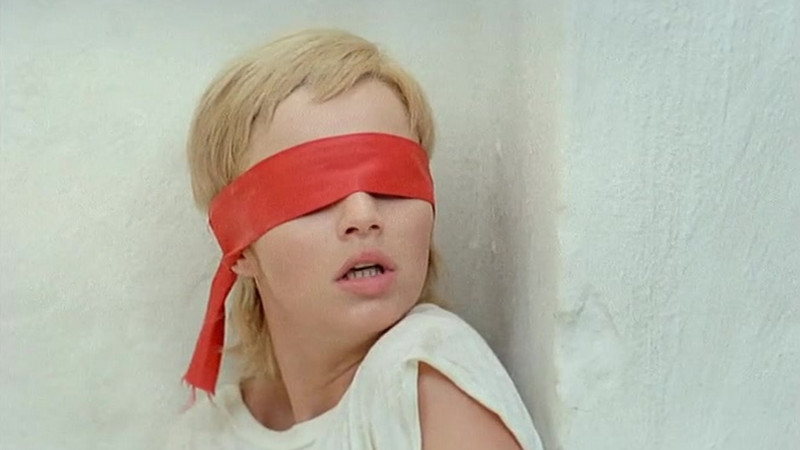
This list/article is the fifth in a series arguing that for cinema to-be-and-to-be-taken-seriously as an art-form, it must forgo-and-move-beyond Hollywood-like visual-based ways-of-meaning-formation/understanding into actor-, face-, dialogue-, voice-, emo-tion-, body-, character-, feeling,-, behavior/psychology-, and tone-based ones.
Readers are strongly advised to read my four previous articles, especially (though-by-no-means-only) the lengthy-theoretical/aesthetic introduction to the first, which obvious-ly-cannot be reprinted here for reasons of brevity, for a fuller understanding of this intellectual/critical project (and also because some important information contained therein about several directors to be discussed will also not be reprinted).
1. Germany, Year Zero (1948, Roberto Rossellini)
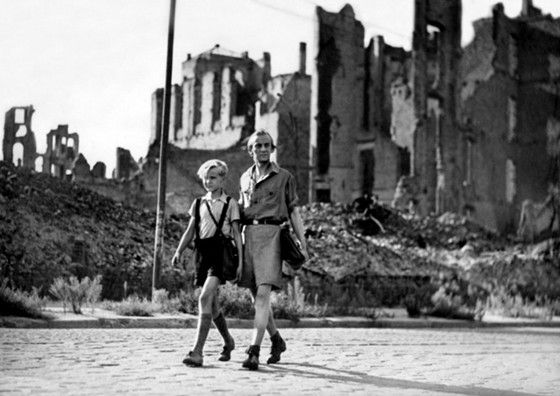
Eschewing “cinematic-gaze/language/devices/expression” shortcuts-to-understanding-self-and-character, in-stantly-telling viewers how to feel regarding characters/self, this film refocuses on body/face/emotion/psychology/acting/dialogue/tone.
Paisà (1946), in critic Colin MacCabe’s, writing for the Criterion Collection DVD insert, words, is a film “[i]n which the role of language is to obscure rather than reveal[, f]rom the opening dia-logue between Joe and Carmela, in which neither can speak the other’s language, the film insists on the distance between intention and reception in speech[, e]ven when language does communicate, it often does so by accident[, t]he most moving example of this comes at the end of the fourth episode, when a dying partisan tells the English nurse that Lupo is dead, completely unaware of the fact that he is speaking to Lupo’s lover[, t]his emphasis on language as miscommunication seems at odds with Paisan’s message of the universal brotherhood of man, and it is a contradiction left unresolved by [Roberto] Rossellini in the end, enduring at the heart of his remarkable film[, a]ny simple description of [which] would make it sound both miserable and despairing, but the verve of the stories and the sense of the camera finding realities as yet unseen ac-tually make it one of the most inspiring and energizing of films[, i]t was a prizewinner at Venice, although its reception in a politically divided Italy was mixed: too Christian for the communists and too communist for the Christians.”
Critic Jonathan Rosen-baum (op. cit.) describes Deutschland im Jahre Null as a film in which “[u]nlike the more aesthetically and intellectually conceived French New Wave, Italian neorealism was above all an ethical initiative—a way of saying that people were important, occa-sioned by a war that made many of them voiceless, faceless, and nameless victims[, b]ut this was, of course, a conviction that carried plenty of aesthetic and intellectual, as well as spiritual, consequences, including some that we’re still mulling over today[, Edmund] Koehler, who struggles to help support his desperate family (including an ailing father and older sister and brother)[, the] story concluding both horribly and logically with Edmund’s suicide after he fatally poisons his father—an act that pro-ceeds no less logically from statements by both his former teacher (espousing the sur-vival of the fittest) and his father himself (about wishing he were dead)[, s]ignificantly, Edmund’s family is split between his anti-Nazi father and his pro-Nazi older brother [yet] one never feels that Rossellini is limiting his sympathy to ideological allies[, a]t worst, he may overload the motivations for Edmund to poison his father and the mel-odramatic villainy of two predatory pederasts, but these might ultimately be consid-ered more flaws in his dramaturgy than humanistic failures[, t]hey count for little alongside the film’s more acute and far more numerous everyday observations about postwar Berlin.”
2. Je, tu, il, elle (1974, Chantal Anne Akerman)
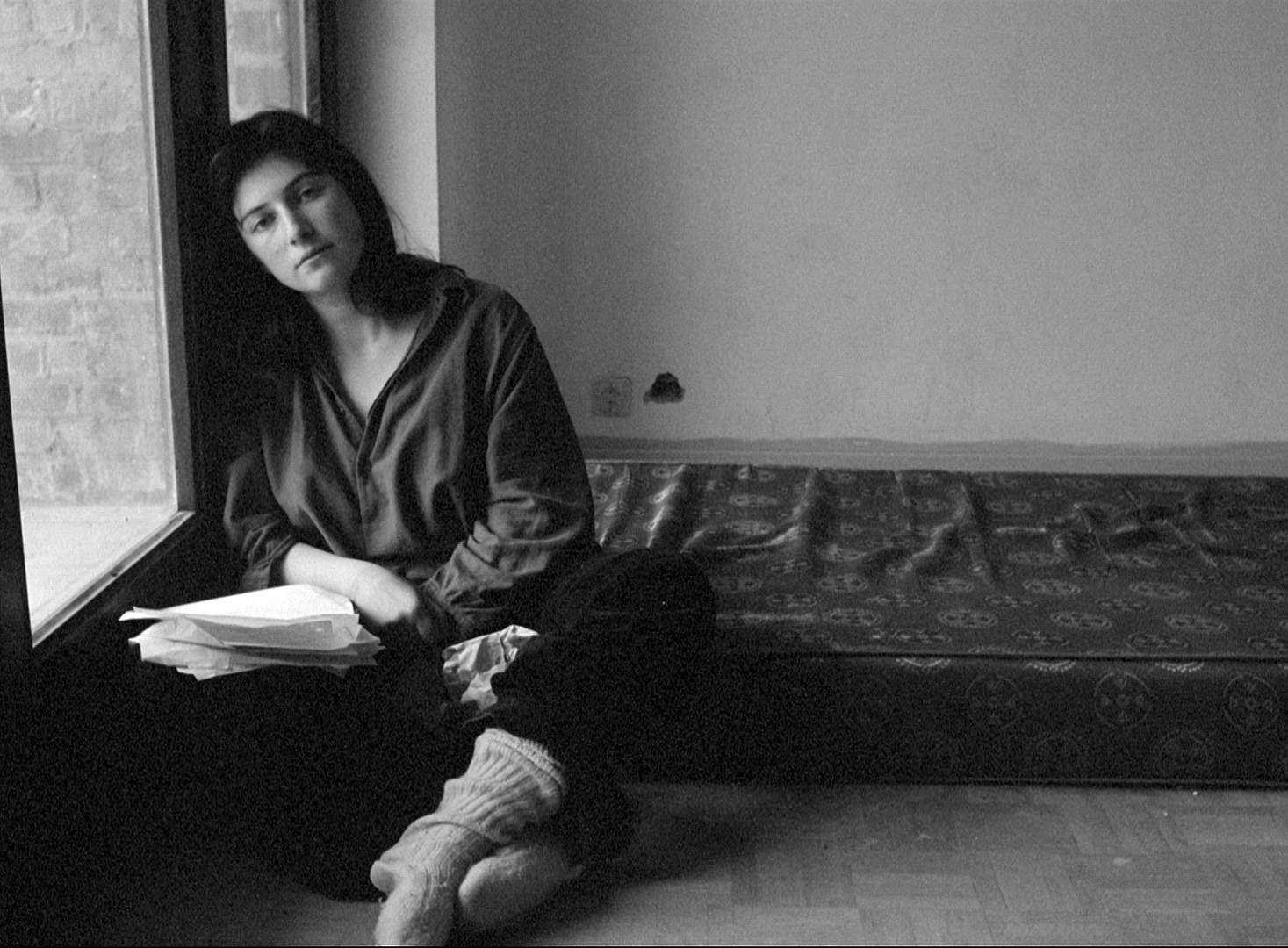
In a sane world, calling a film “uncinematic-merely-filmed-literature-or-theatre,” that is, comparing a work from a medium 99.95% of which is artistically-worthless to a veteran-medium with a much-larger number of emotionally-profound/life-changing-masterpieces, would have been the ultimate-compliment. In our perpetually-adolescent world, run by testosterone-fueled-dudebros, auteurist/formalist journalists, obsessed with technical/technological tricks and uninterested in life, find emotions, psychology, feelings, human interactions, characterizations, acting, etc. uninteresting (i.e. “unmanly”) and think they should be replaced with decoder-ring-visual/virtuosic-camera-movements/positions, easily-deconstructed without any emotional knowledge about life and emotional complexity necessary for the difficult work needed to understand physical, verbal/vocal, and to-nal shifts-and-turns, that convey to even the most unsophisticated viewer within two seconds how they are supposed to feel like regarding a character and how a character feels like (either that or generic messages-and-themes one also understands within five seconds through same method).
Cinema, because these folks do not think about it in terms of emotions but only in term of tricks, has nothing to learn, according to them, from more veteran/non-visual (“inferior”) artforms, as they are based on “boring” emo-tions and the difficult work necessary to understand them, rather than on easily-decoding visual cues within two seconds and learning nothing.
With a fixed and con-stant/never-moving camera being merely functional, few editing-techniques, eschewal of simplistic and easy/obvious “cinematic language/expression,” etc. Chantal Anne Akerman presents a series of lengthy scenes with few props-and-such containing little-more than characters discussing their loves-and-lives.
In her films, knowledge comes from paying attention to the actors’s bodies and faces, rather than to camera-angles and the like, demonstrating once again that seeing several actors interacting is more interesting than any car-chase or reptilian/thrillerish “storytelling” and “plot” ap-proaches with even-more-reptilian “plot-twists.”
Experimental/silent documentary Hô-tel Monterey (1975), which only has 487 IMDb votes now, is a piece of Americana following a run-down/cheap New York hotel, showing how sad those places can be.
In critic Michael Koresky’s, writing for the Criterion Collection DVD insert, words, “Akerman transforms a run-down Upper West Side single-room-occupancy hotel (where she had sometimes spent nights with a friend) into a site of contemplation and unconventional beauty[, t]here was barely any planning: Akerman knew only that she would start filming on the hotel’s main floor and end at the top, and that she wanted to emerge from dark into light, night into day,” while 1977’s News From Home (which only has 905), in which Akerman reads letters she received from her mother, is a film in which “we learn much about Akerman’s home life, if mostly the mundanities, such as birthdays, babies, and illnesses—and if you know that Akerman’s parents are Holocaust survivors, her mother’s desperation to keep in contact becomes all the more poignant[, y]et we also gradually begin to suspect Akerman’s reasons for leaving[, t]he content of the letters constitutes something of a linear narrative, as the tone of the writing moves from inquisitive (‘Please write about your work and your life there’) to passive-aggressive (‘I was surprised not to get a letter this week’) to agitated (‘You never answer my questions, and it’s bothering me. Please answer this time’)[, b]y matching her mother’s words with images of dirty old diners, storefronts, and public transportation (never any interiors of houses or apartments), Akerman creates a palpa-ble sense of alienation—from home, from family, from past, from identity[, s]he has remarked that her interest in structural cinema and its play with repetition, rhythm, and expectation may stem from her Jewish upbringing, with its precise rituals,“ and Je, tu, il, elle (which has only 1,270) “dramatizes a woman’s desperation to control her own life[, r]ather than remain a prisoner of the stifling rhythms and spaces of the home, this protagonist ultimately refuses confinement[, h]er simultaneous desire for freedom and need for order make for a decidedly odd character[, o]f complete dissociation[, from] body, from life.”
3. Ordet (1955, Carl Theodor Dreyer)
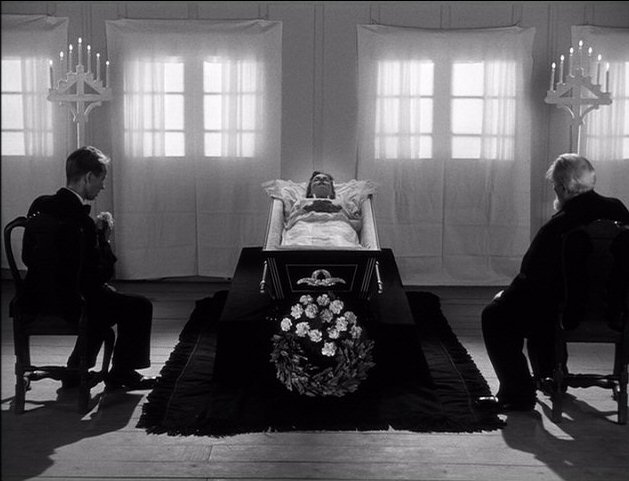
Nouvelle Vague testosterone-fueled dudebros (and their journalist acolytes), uninterested in life and emotions yet infatuat-ed with technical/technological visually-based tricks, hated the “uncinematic” (i.e. ac-tually-emotionally-profound) cinema of Carl Theodor Dreyer.
His radical attempts to cleanse cinema from Hollywood’s and the macho journalistic establishment’s, infatu-ated with decoder-ring instant-knowledge and “purely-cinematic” easy-ways-of-understanding, unable to even-think of cinema in terms of human interactions, learn-ing-about-life, and emotions, or, indeed, anything but technical-tricks and generic messages decoded through them, hating on “merely-filmed-non-cinematic-literature-and-theatre” i.e. anything that deals with emotion and actually-requires knowledge-about-and-interest-in-life, eschewing of and lack-of-any-interest in emotional-and-psychological complexity and difficult perceptual acting-based tonal shifts-and-experiences in-favor of easily-decodable shortcuts-to-emotional-experiences by which verbal and corporal acting viz. human language and expression is replaced with “cine-matic-language-and-expression,” that is, visual tricks, understandable within two sec-onds, with no understanding of life and with no knowledge thereof or about anything else but how cameras operate, spoon-feeding even the most unsophisticated viewer with how they are supposed to feel about a character and with how the characters are supposed to feel in a generalized-formulaic-allegorical way without uncertainties and contradictory feelings, eschews hacks’s spoon-feeding viewers with camera-tricks be-stowing upon them such easy and simplistic-clear-obvious-nugatory-stylistic modes-of-knowing.
He made audiences learn valuable-unframed lessons about the complexi-ties of life and truly-experience new emotions following serious work with the actors emanating from eschewal of tricks.
Witchhunt-tale Day of Wrath/Vredens Dag (1943) was described by critic Ray Carney as a film in which “our physical selves and sexual energies[, o]ur bodies are the way we express our spirits for Dreyer[, there] are scenes of sexual encounters, or references to sexual encounters[. o]ur practical sexuality is one of the principal ways we express our emotions in the world[, o]ne of the ways in which Dreyer asserts an alternative to the semiotic depersonalizations and neutraliza-tions represented by Absalon [Pederssøn] and the churchmen is through a reinstalla-tion of the actual physical body into a depersonalized expressive system like that of the church’s rituals of interrogation and torture. Herlofs Marte’s body in particular represents a realm of the senses that is pointedly not accounted for by the theological abstractions involving sin and transgression in the books of the church elders and the confession she is tortured into giving[, r]einstalling the human body and senses, in all of their ungeneralizable particularity, at their place at the center of life, and as the fundamental source of all expression, is only one step in a larger expressive project in which Dreyer is engaged,” he described Ordet as a film in which “camera movements [are] not masterful and manipulative[, r]e-framings are not tendentious and virtuosic [Hollywood-style but] diligent and scrupulous acts of knitting persons together[, slow and ponderous[, h]esitant and tentative[, d]eliberate and deliberative[, m]ake us aware of the work of weaving separated threads together, slowly, conscientiously, diligently.”
Critic Chris Fujiwara, in his Criterion Collection DVD insert, described Ordet as hav-ing “little plot in the familiar sense, and no single main hero[, t]he possibility looms that the main action of the film will coalesce around the desire of Anders [Borgen], the third son, to marry Anne [Petersen], the daughter of a tailor[, b]ut Anders isn’t a hero (he’s just a pleasant young man who knows his place and whom we don’t get to know well—he’s very much the third son), and the pale, shy, and silent Anne is even less than that[, Ordet] is not a ’plot‘ film[, i]t’s an intense and turbulent poem.” Jona-than Rosenbaum (op. cit.) wrote that Vredens Dag “lend[s] a multidimensional impact to each gesture, word, and emotion.”
4. Shadows of Forgotten Ancestors (1965, Sergei Parajanov)

Sergei Para-janov’s (სერგო ფარაჯანოვიСергій Параджанов, 9 January 1924, Tbilisi, Georgia – 20 July 1990, Yerevan, Ar-menia) and Dodo Abashidze’s (დავით აბაშიძე, 1 May 1924, Tbilisi – 26 January 1990) masterpieces, whose titles are Тіні забутих предків (Ivan falls-in-love with the daughter of his father’s killer among Ukraine’s Hutsul), The Legend of Suram For-tress/ამბავი სურამის ციხისა (1985, which has only 1,298 IMDb votes, a boy im-mured-into-the-walls-of-a-fortress-in-order-to-stop-it-from-crumbling-to-pieces), and Ashik Kerib/აშიკ-ქერიბი (1988, which has only 1,322, a minstrel falls-in-love with a rich merchant’s daughter and forced to roam-the-world for a thousand and one nights), are non-narrative and plotless celebrations of the entire range of life’s emotions – family, love, growing-up, happiness, loneliness, depression, death, adolescence, folk-loristic/religious/historical/ethnographic pride – requiring the viewers to pay attention step-by-step-and-within-the-flow to bodies, dialogues, faces, emotions, vocal/verbal tones-and-turns, feelings, psychology, etc., while ignoring the nurtured urge to try and pin/pigeonhole it all-down into some grand theme symbolically-metaphorically or to interpret it via “cinematic language” that will not make differences from spoon-feeding instant Hollywood-cinema apparent, like style-obsessed formalist/auteurist journalists and dudebros obsessed with “cinematic-expression” (and uninterested in human emotions).
5. Katzelmacher (1969, Rainer Werner Fassbinder)
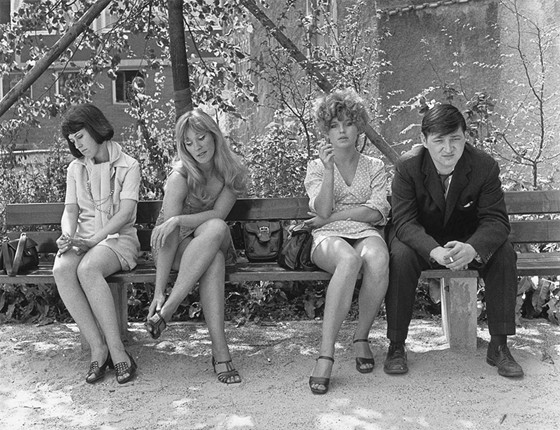
The journalistic estab-lishment has never forgiven/accepted Rainer Werner Fassbinder. The formal-ist/auteurist camp for the fact that his films are largely “uncinematic-merely-filmed-literature-or-theatre” (i.e. actually-emotionally-profound, not based on visual shortcuts understandable within two seconds).
The “film-theory” types for being politically-incorrect rather than parroting their “social-justice/”middle-class ideology of black-and-white/innocent-angelic “victimhood” back to them, forgetting that real-life is nev-er about comic-book-villains-versus-good-folks. While these people correctly-underscore that film must challenge viewers, having it backwards, they mean it needs to challenge people they disagree with. The last thing on their minds is films challeng-ing their axiomatic/predetermined politics, which they just assume is correct, and such films are frowned-upon.
Critic Michael Töteberg, in his Criterion Collection DVD in-sert, notes that in 1981’s Lola “‘[a]ll sorts of things can be told better about women; men usually behave the way society expects them to,’ explained Fassbinder in an in-terview[, h]is screenwriter was also convinced that ‘men in reality are becoming more and more boring—how can you tell identification stories about these gray, adjusted, disconsolate men?’ [Peter] Märthesheimer: ‘[a]s far as men are concerned, it is instruc-tive that in Lola, from a purely dramaturgical point of view, it is not Lola who is the hero, but rather Mr. von Bohm[, a]nd what are we told about our hero? That he is a victim[, s]o the secret hero is Lola after all,’” while critic Kent Jones (op. cit.) notes that “Lola [is a] necessity hard-nosed [woman], working twenty-four hours a day to construct futures [from] nothing, using [sexuality] as a weapon, or at the very least as a bartering tool.”
1969’s Liebe ist kälter als der Tod/Love Is Colder Than Death (which only has 2,300 IMDb votes) was described by Michael Koresky (op. cit.) as “em-ploy[ing] a chilly, detached aesthetic—inspired by the experimental work [of] Jean-Marie Straub—to subvert American gangster movie clichés[, t]he film also thwarts conventional audience identification with its protagonists[, t]hey are like mannequins, posed in static tableaux, often in stark, white rooms. Fassbinder’s camera rarely moves as it surveys their follies in self-consciously long takes[, t]here’s no glamour to the lives of gangsters in his world—he sees them not as cool rebels,” Katzelmacher (about a Greek migrant-worker and with only 2,114) as “clinical in tone[, d]epicts modern Germany as being in a state of catatonia, perhaps held there by the ever-present bur-den of history[, t]e camera rarely moves[, c]alling attention to cinematic form as well as social injustice and petty inhumanity,” 1970’s Götter der Pest/Gods of the Plague (which has only 1,029), another satirical view of Hollywood’s crime flicks, as “illus-trat[ing] the futility of romance and the inevitability and ignominy of death,” and 1970’s The American Soldier/Der amerikanische Soldat (which has only 1,430) as “deconstruct[ing] noir tropes[, t]reading the line between satirical pastiche[, his] bold-est and most fragmented film of this type, a metacinematic take on a genre known for its pitiless violence.”
6. Bicycle Thieves (1948, Vittorio De Sica)
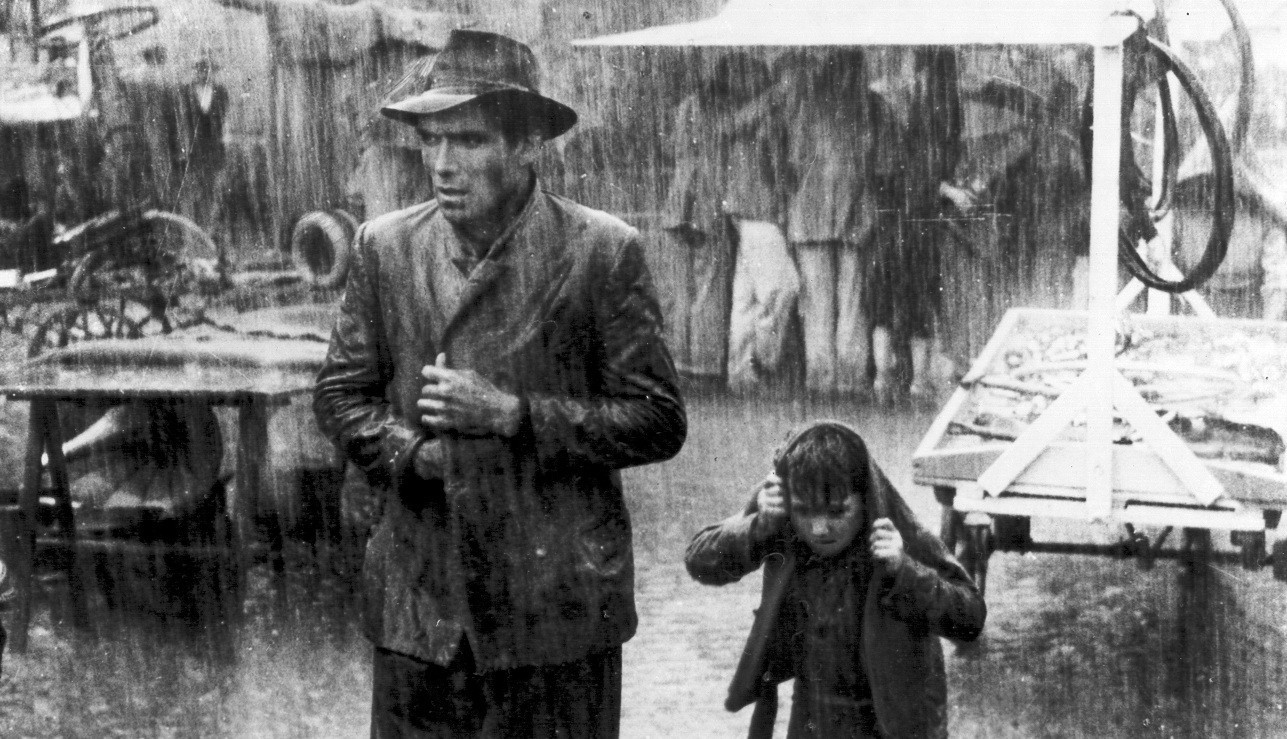
Ladri di biciclette demonstrates that, contrary to Marxist dogma, men do not despise work but, rather, find it a mean-ingful source of inspiration and self-worth, which is why the film’s ending, in which Antonio Ricci is humiliated in front of his son, Bruno, after losing his bicycle (and, hence, his ability to work, namely, his dignity), drives this point home.
Ray Carney notes that “[in Hollywood] the style tells the story much more vividly, powerfully, and completely than the rather banal lines of dialogue do[, characters] are largely ex-onerated from having to do or say anything, while a dazzling display of stylistic ef-fects ‘speaks’ for them[, t]heir facial expressions are almost blank; and their verbal ex-changes are minimal[, m]eanwhile, the moment is overflowing with stylistic expres-siveness: a rapid succession of tight close-ups, high-key lighting, brisk editing rhythms, emotionally charged musical orchestrations, rhetorical camera movements (dollying and panning movements), and a few dramatic sound effects[, t]he expressiveness of the music, sound effects, and images is far greater than anything the characters say or do[, a]s even a student in Film 101 realizes, [they] systematically and comprehensively [transform] the driving, the rain, and the night into representations of subjectivity[, s]torminess figures a storm of feeling[, b]uildup of external disturbance communicates a crescendo of emotional disturbance[, t]he scene is less about geographical disorienta-tion than imaginative lostness, less about outer than inner weather[, e]ven the most naïve viewer knows that the lugubrious music on the soundtrack, the languorous cam-era movements and dissolves, the shadowy lighting, the chain link fence, the ‘No Trespassing’ sign, the dilapidated grounds, the lonely mansion, the dying words of the man in the bed all function metaphorically[, t]he meaning of people, places, and things in these films can be read by a member of the audience more or less instantaneously[, k]nowledge can be this quick (for both characters and viewers) because it is an ab-stract, intellectual event[, t]akes place in a glance, at a distance, intellectually—the way we learn a fact or recognize a sound or a color[, t]his recognition knowledge is a special and very limited kind of knowledge[, d]efined as insight rather than acquaint-ance—as ‘knowing something’ rather than ‘getting to know it[,’ f]amiliarity, extended, nuanced contact with the subject would actually get in the way of this sort of quick knowledge[, t]hey push the pause button on the ebb and flow of lived experience[, t]he viewer is told how to feel about some aspect of the character or his situation once and for all[, w]e ‘get’ these truths [like] the punch-line of a joke; we don’t live into them [like] a George Eliot novel[, c]ontrast [with] the meal Antonio and Bruno eat [to] appreciate the pervasiveness of [Hollywood’s] derealizations[, a]s [Bicycle Thieves] dazzlingly demonstrates, everything that makes life most fascinating is the result of unexpected glances and movements at a physical right-angle to where we thought we were headed, at an imaginative angle to our intentions, goals, and focuses[, w]hen [characters in Hollywood work their] way into an upstairs bedroom[, they are] getting ever closer to the truth; when Antonio does the same thing, he is only pursuing one more dead end[, f]ilm important emotions[, horror/action/thriller-flicks are] full of emotions, but trivial ones[, o]ur flight-or-fight responses are the least interesting part of us[, t]hey are our reptilian brain stems[, m]ake a movie about what makes us human, not what we have in common with a crocodile.”
Charles Burnett, in his Criterion Col-lection DVD insert, underscored that “[t]here is a group of filmmakers like myself who wanted to counter the distorted narratives and stereotyped images of Hollywood, and on seeing Bicycle Thieves, I was moved by how ordinary people were able to ex-press so much humanity[, a]chiev[ing] in very simple terms what I was looking to do in film: humanize those watching. Bicycle Thieves has the quality and intention of a documentary[, i]t is totally unromantic[, t]he characters are just ordinary people, and the film gives the impression [of] life.“
7. Earthquake in Chile (1975, Helma Sanders-Brahms)
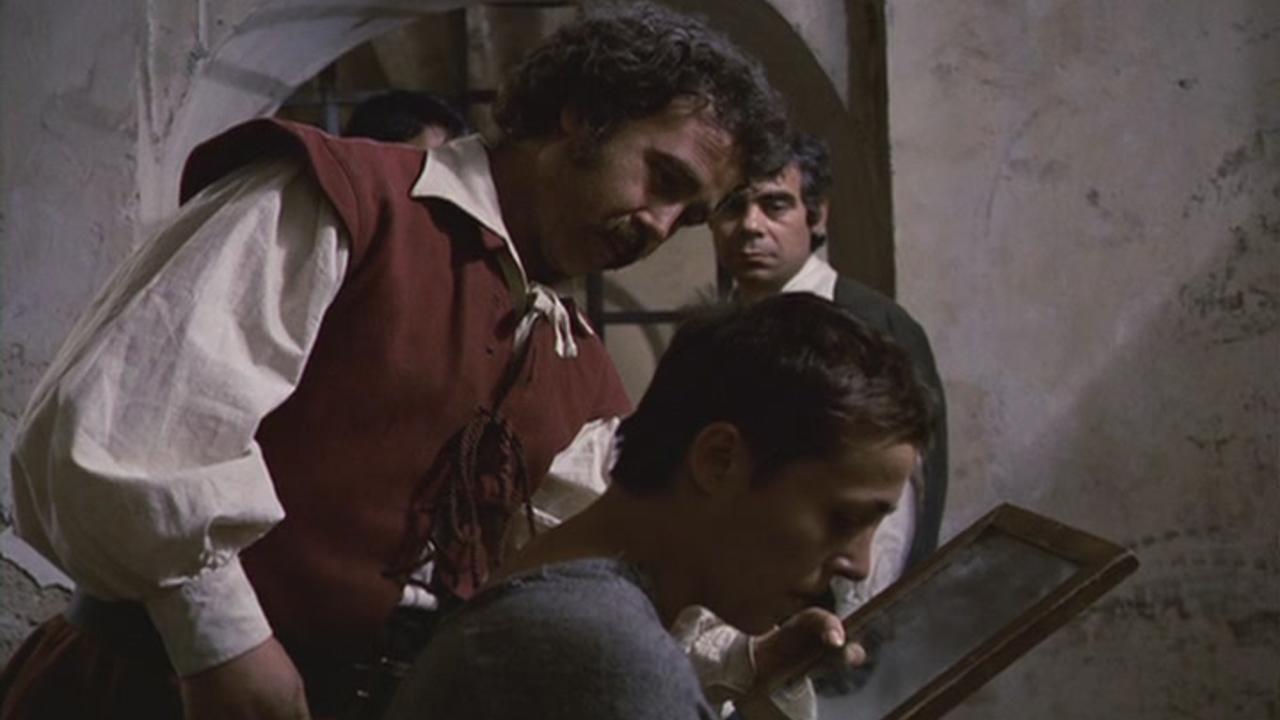
Das Erdbeben in Chili, which has only 21 IMDb votes, little-known Neuer Deutscher Film/New Ger-man Cinema filmmaker Helma Sanders-Brahms’s “talky/uncinematic-merely-filmed-literature/theatre-without-any-utilization-of-cinematic-gaze/devices/expression-or-language” (i.e. emotionally-profound and complex, dealing with confusing-and-bewildering emotions) film, demonstrating how “uncinematic-merely-filmed-literature-and-theatre-without-any-usage-of-cinematic-gaze/expression/devices/language” actually-requiring viewers to have knowledge of life and create meanings out of difficultly-working with the actors’s bodies/faces, physical and tonal/vocal/verbal shifts-and-turns, dialogues, etc., by learning about life and emotions and by experiencing truth-based experiences, is vastly superior to Hol-lywood’s method of creating shortcuts-to-understandings-self-and-character by hav-ing viewers merely decode camera-angles and understand everything within two sec-ond by not learning anything that matters and by not requiring them to know anything that matters, deals with a woman banished to a convent after an illicit affair, awaiting her execution. A moment before her public execution, an earthquake devastates Santi-ago. Josepha Asteron finds her baby and flees the rubble while Jeronimo Rugera sur-vives, escapes, and finds her.
8. Amarcord (1973, Federico Fellini)
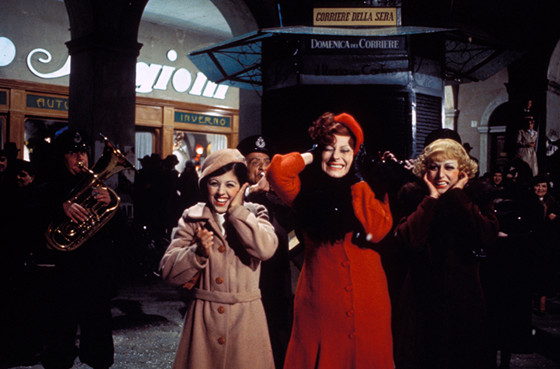
Critic Sam Rohdie, in his Criterion Collection DVD insert, described this coming-of-age masterpiece, one of the greatest depiction of burgeoning male sexuality in the entire history of cinema, as being “like a circus, composed of numbers, perfectly linear and sequential but whose links are nei-ther logical, dramatic, nor narratively motivated[, e]ach of the numbers in the film is a circus act, and the actors are the circus clowns[, i]ndeed, there is no story in Amarcord, simply a collection of these episodes, whose order is only marginally consequential or where consequence is not of great importance: the seasons will change, Miranda [Blondi] will die, Gradisca will marry[, s]ince the figures are essentially only images that have been designed, sketched, and exaggerated, rather than developed and given body to, they are simultaneously eternal and ephemeral, like the ocean liner Rex, which appears in its impossible magnificence out of the blackness of the sea at night, bringing Gradisca to tears and the others in boats to shouts of astonishment at the un-real wonder of it, in a kind of maritime séance[, e]ven fascism is made into spectacle: were this a realistic film, fascism would be a politics that would eventually be over-come; in Amarcord, because fascism is only an act of clowns dressed up in a circus, it seems to be timeless, a perpetual provincialism and infantilism, more symbolic than historical or real.” Federico Fellini became a Prügelknabe-symbol for explosionfests-loving-dudebros who are convinced the whole-world conspires/works against their love-of-explosions.